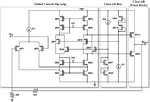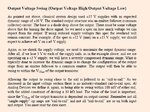Junus2012
Advanced Member level 5

Dear all,
below is the very know to you the class AB OP-amp,
It is by literature or simulation, the output voltage swing towrds rails. However, if we assume that output transistors should be in the saturation region as a condition of operation, then it looks impossible to have rail to rail output swing.
My question, suppose I am using single supply operation with VDD = 3.3 V, and I want the output signal to swing between 0.3 and 3 V,
take now the cade where Vo = Vomin = 0.3 V and prove please that MN9 is in the saturation region,
here is my solution, for MN9 to be in saturation then VDS(sat)(MN9) >=VGS(MN9)-Vthn,,,,
say we are at the border of sat then VDS(sat)(MN9) =VGS(MN9)-Vthn
Subsitute the value of VDS sat(MN9) and Vthn results in VGS <= 0.9 V
to find VGS(MN9) from kirschoff voltage loop at the gate of MN9 to VDD , thus VGS= VDD-VDS sat(MP4)-VDS sat(MP6)- VDS sat(MP8)
if you assume typical values of VDS sat(MP4)=VDS sat(MP6)-=VDS sat(MP8)=150 mV and Vthn = 0.6 V.....then VGS-Vthn =2.25 V
Since 2.25 V is greater than 0.9 V, it means driver transistor MN9 is at triode region even before appraoching the maximum value

Thank you in advance
Regards
below is the very know to you the class AB OP-amp,
It is by literature or simulation, the output voltage swing towrds rails. However, if we assume that output transistors should be in the saturation region as a condition of operation, then it looks impossible to have rail to rail output swing.
My question, suppose I am using single supply operation with VDD = 3.3 V, and I want the output signal to swing between 0.3 and 3 V,
take now the cade where Vo = Vomin = 0.3 V and prove please that MN9 is in the saturation region,
here is my solution, for MN9 to be in saturation then VDS(sat)(MN9) >=VGS(MN9)-Vthn,,,,
say we are at the border of sat then VDS(sat)(MN9) =VGS(MN9)-Vthn
Subsitute the value of VDS sat(MN9) and Vthn results in VGS <= 0.9 V
to find VGS(MN9) from kirschoff voltage loop at the gate of MN9 to VDD , thus VGS= VDD-VDS sat(MP4)-VDS sat(MP6)- VDS sat(MP8)
if you assume typical values of VDS sat(MP4)=VDS sat(MP6)-=VDS sat(MP8)=150 mV and Vthn = 0.6 V.....then VGS-Vthn =2.25 V
Since 2.25 V is greater than 0.9 V, it means driver transistor MN9 is at triode region even before appraoching the maximum value

Thank you in advance
Regards



